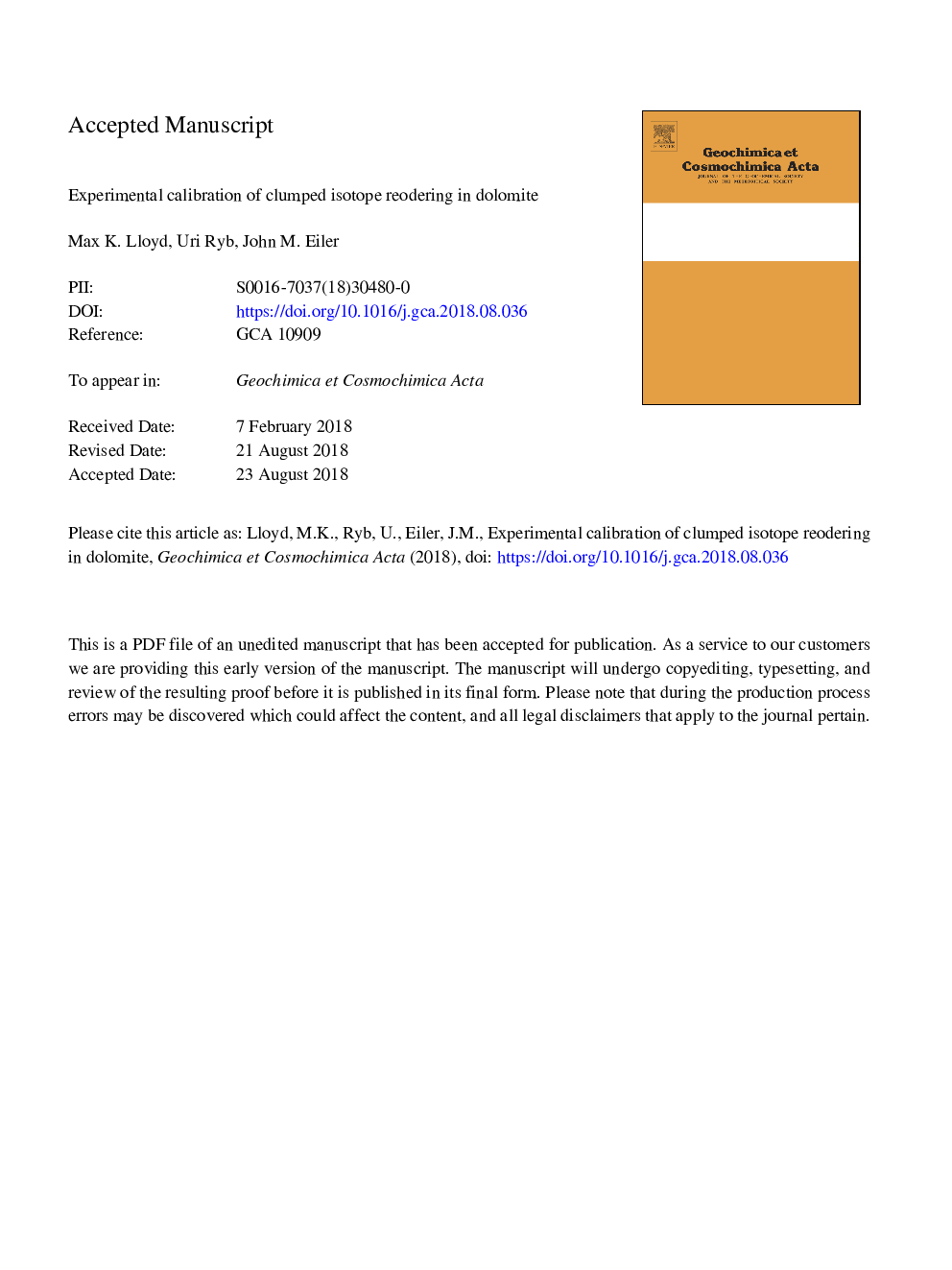| کد مقاله | کد نشریه | سال انتشار | مقاله انگلیسی | نسخه تمام متن |
|---|---|---|---|---|
| 10224343 | 1701097 | 2018 | 44 صفحه PDF | دانلود رایگان |
عنوان انگلیسی مقاله ISI
Experimental calibration of clumped isotope reordering in dolomite
ترجمه فارسی عنوان
کالیبراسیون تجربی از مرتب سازی ایزوتوپ کلومت در دولومیت
دانلود مقاله + سفارش ترجمه
دانلود مقاله ISI انگلیسی
رایگان برای ایرانیان
کلمات کلیدی
ایزوتوپهای کلوخه، دولومیت، نفوذ، مبادله حالت جامد،
موضوعات مرتبط
مهندسی و علوم پایه
علوم زمین و سیارات
ژئوشیمی و پترولوژی
چکیده انگلیسی
Dolomite clumped isotope compositions are indispensable for determining the temperatures and fluid sources of dolomitizing environments, but can be misleading if they have modified since formation. Carbonate Î47 values are susceptible to resetting by recrystallization during diagenesis, and, even in the absence of dissolution and reprecipitation reactions, alteration by solid-state reordering during prolonged residences at elevated temperatures. In order to understand the potential of dolomite Î47 values to preserve the conditions of dolomitization in ancient sections, the kinetic parameters of solid-state reordering in this phase must be determined. We heated mm-sized crystals of near-stoichiometric dolomite in a René-type cold seal apparatus at temperatures between 409 and 717â¯Â°C for 0.1-450 h. In order to prevent the decarbonation of dolomite to calcite, periclase, and CO2 at these conditions, the system was pressurized with CO2 to 0.45-0.8 kbar. Over the course of 31 temperature-time points and 128 individual Î47 measurements of powdered dolomite crystals from these points, we observed the evolution of dolomite Î47 values from the initial (unheated) composition of the crystals (0.452â¯Â±â¯0.004â°, corresponding to a formation temperature of â¼145â¯Â°C) towards high-temperature equilibrium distributions. Complete re-equilibration occurred in the 563-717â¯Â°C experiments. As with previous heating experiments using calcite and apatite, dolomite Î47 exhibited complex reordering behavior inadequately described by first-order Arrhenian-style models. Instead, we fit the data using two published models for clumped isotope reordering: the transient defect/equilibrium defect model of Henkes et al. (2014), and the exchange-diffusion model of Stolper and Eiler (2015). For both models, we found optimal reordering parameters by using global least-squares minimization algorithms and estimated uncertainties on these fits with a Monte Carlo scheme that resampled individual Î47 measurements and re-fit the dataset of these new mean values. Because the exact Î47-T relationship between 250 and 800â¯Â°C is uncertain, we repeated these fitting exercises using three published high-temperature Î47-T calibrations. Regardless of calibration choice, dolomite Î47 rate constants determined using both models are resolvably slower than those of calcite and apatite, and predict that high-grade dolomite crystals should preserve apparent equilibrium blocking temperatures of between â¼210 and 300â¯Â°C during cooling on geologic timescales. Best agreement between model predictions and natural dolomite marbles was found when using the exchange-diffusion model and the ab initio Î63-T calibration of Schauble et al. (2006), projected into the Î47 reference frame by Bonifacie et al. (2017). Therefore, we recommend modeling dolomite Î47 reordering using the exchange-diffusion model and this parameter set. In simple heating scenarios, the two models disagree. The transient defect/equilibrium defect model suggests that dolomite fabrics resist detectable reordering at ambient temperatures as high as 180â¯Â°C for tens of millions of years, while the exchange-diffusion model predicts incipient partial reordering perhaps as low as 150â¯Â°C. In either case, barring later recrystallization, dolomite Î47 values should be faithful recorders of the conditions of dolomitization in sedimentary sections buried no hotter than â¼150â¯Â°C for tens of millions of years.
ناشر
Database: Elsevier - ScienceDirect (ساینس دایرکت)
Journal: Geochimica et Cosmochimica Acta - Volume 242, 1 December 2018, Pages 1-20
Journal: Geochimica et Cosmochimica Acta - Volume 242, 1 December 2018, Pages 1-20
نویسندگان
Max K. Lloyd, Uri Ryb, John M. Eiler,
